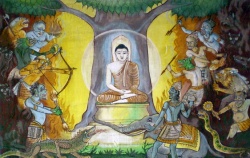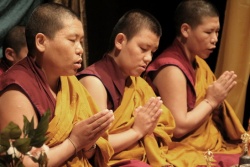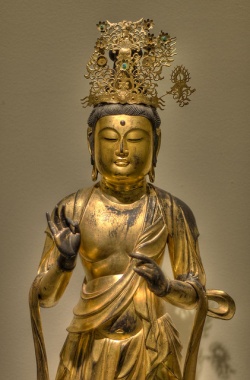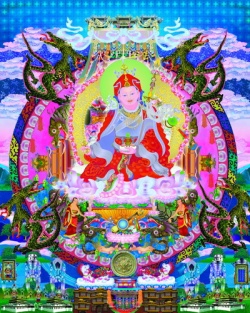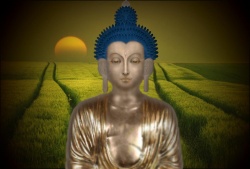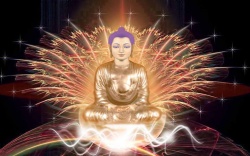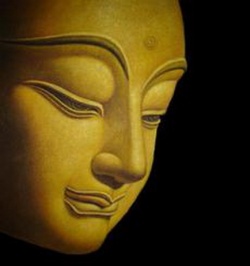Exploring Bhāviveka's Epistemology
—Exploring Bhāviveka's Epistemology
Su-an Lin
This paper discusses the relationship between language and the ontological status of phenomena, in the sense that if everything must be "certified" in and of itself, then the concept of language would be meaningful. In other words, if a thing does not exist, is it possible for language to refer to it? I start with Tsong-kha-pa's viewing Bhāviveka as one who asserts, "things are established from their own entity conventionally", with reference to Bhāviveka's works on the topic of universals (sāmānya), to explore Bhāviveka's own standpoint to determine whether there is evidence to support this assertion.
In Tsong-kha-pa's interpretation of Mādhyamika, the major difference between Prasaṅgika and the Svātantrika school following Bhāviveka is the assertion in Svātantrika that everything has its own entity (rang gi mtshan nyid kyis grub pa, *svalakṣaṇasiddha) from the aspect of conventional truth. In Tsong-kha-pa's work Buddhapālita, The Essence of Eloquence:
A Treatise on the Differentiation of Interpretable and Definitive Meanings, he interprets Bhāviveka as saying that all phenomena exist by way of their own character:
In the Prajñāpradīpa, Bhāviveka criticized his opponent's assertion of the non-existence of the imputational nature, saying:] “If the character of the imputational nature which is expressed as the apprehended character in mental formulations and words does not exist, that would be a deprecation of the existent (dngos po) because of being a deprecation of that expressed by mental formulations and words [because the existence is established by mental formulations and words]."
This explains that calling the imputational nature an imputational character non-nature is a deprecation [also] of the other-powered as being without a character nature. Hence, it is an explanation that Bhāviveka asserts other-powered natures have a character nature [i.e., they also exist by way of their own character.
Here Tsong-kha-pa appears to be saying that according to Bhaviveka one develops an attachment to the imputational imaginary nature (thinking that everything exists inherently) based on other-powered phenomena. This attachment to the imaginary comes from the object established by concepts and words. Therefore, when yogacaras negate the imputational imaginary nature, it will result in the negation of mental formulations and words.
Bhāviveka attacks the Yogacara position on negating the imputational imaginary nature since he feels it will result in the negation of mental formulations and words in general, thereby resulting in the negation of the own-entity of the other-powered. For Tsong-kha-pa, this means that Bhāviveka admits that other-powered phenomena are established from their own entity.
Tsong-kha-pa reasons that Bhāviveka's attack on this Yogacara position has as its basis Bhāviveka's attempt to assure or certify the existence of phenomena. Only when the existence of phenomena have been certified, can language fulfill their function of referring to objects. To explain this, Bhāviveka employs the metaphor of seeing a rope as a snake as understood by Yogacara.
Whether he has correctly understood the Yogacara position here is not the point. He interprets this metaphor within Yogacara by explaining that there are two parts to it: the illusion that the rope is a snake (the snake being the imputational nature in this metaphor) and the real existing rope (which is the other-powered nature in this metaphor).
For Tsong-kha-pa, Bhāviveka's analysis of the Yogacara position is that it would follow for the Yogacarins that if they refute the imaginary, they would also be deprecating the other-powered. This would be like binding together the other-powered (the rope) and the imaginary (the snake), such that refuting the imaginary also negates the other-powered.
In other words, Bhāviveka feels that the Yogacara system is such that it would not be possible to separate the imaginary and the other-powered so the former could be refuted without deprecating the latter. It is my opinion that this is due to the fact that Bhāviveka feels that the mind-only system connects these two natures as non-external entities within the mind, whereas his own system does not have this fault, since it separates the imputational and the other-powered, the former being within the mind and the later being established by way of its own entity conventionally as an external phenomenon.
As we have seen, it is Tsong-kha-pa's interpretation of Bhāviveka's understanding of the rope and snake example in the Yogacara system that if the snake does not exist at all in the rope, then the rope also does not exist at all. To examine this further, let us look at one of the most important of Bhāviveka's works, the Heart to the Middle way (Madhyamakahṛdayakarikāḥ) and his own Commentary on the Heart to the Middle way (Madhyamakahṛdayavṛttitarkajvālā,The flame of Reason). Verses 55 and 56 in Chap.5 address this issue.
V. 55
We do not think that imagined identity does not exist, because it is imagined, like a snake. This [argument] is inconclusive with regard to the rope and is contradicted by common sense.
Here in verse 55, Bhāviveka introduces his criticism of the Yogacara school's assertion of the non-existence of the imputational by arguing that the non-existence of the imputational negating the existence of the rope is contradictory with common sense. He continues to explain in verse 56-ab
V.56ab
Imagined identity is not completely illusory, because we observe that this example has more than one part. By negating all objects, you make an improper denial of real things.
In this way, Bhāviveka explains that what we see has not only one part -- false illusion -- but also a real part. However, Bhāviveka never directly asserts that things are established from their own entity, and many scholars of Bhāviveka do not agree with Tsong-kha-pa's view that Bhāviveka does assert establishment by way of own entity.
For them, his refutation of the Yogacara school's assertions in verses 55 and 56 does not mean that Bhāviveka asserts the opposite position, as does Tsong-kha-pa. It is therefore important to see if it is possible to understand Bhāviveka's attitude towards to this assertion from the context of his works. What is his epistemological view on the objective referents of words?
In Chap. 5 of his commentary to the Heart to the Middle way, he displays a point of view different from that of the Yogacara school regarding "cognizing universals through anāpoha". It seems Bhāviveka emphasizes the role of the thing itself in the process of cognition.
Therefore, it is worthwhile to explore Bhāviveka's ontological position regarding the conventional world by clarifying his assertions on epistemology.
Scholarly opinions are divided on this point, but it is clear that for the Ge-luks, the term "Svatantrika" includes the meaning of "established from its own power", but what does this mean? How does this relate to his epistemology? When cognizing objects by applying language, what is his assertion towards the object? Let us discuss these questions in detail.
Cognitions Arise Through an Aggregate of Particles
In his commentary on Heart to the Middle Way, Bhāviveka takes issue with Yogacara scholars on the topic of whether the external object exists or not. In verse V.35, he mentions that the object of the senses is the material form of a combination (saṃcita). Here combination has the meaning of the homogenous atoms that are combined in the same place.
V. 35
If [the opponents are arguing about] the material form of a combination (saṃcita), [we] do not accept the reason, because a cognition arises with the appearance of that [combination] when atoms are combined with the material forms of others.
Bhāviveka argues that cognition can be aroused due to the material form of a combination of homogeneous atoms. In other words, the object has to exist prior to the cognition. In his commentary, Bhāviveka clarifies this statement:
"A cognition arises with the appearance of that [combination], that is, with the form of a combination of atoms. We think that a combination of similar atoms, such as a pot, is real in a relative sense. This also is true of atoms themselves, because [we] think that atoms are real as collections of eight things. " [Here is Prof. Eckel's translaiton]
In the commentary to V.39, he mentions that only if the external object exists, can the wisdom of non-conceptuality be possible. Therefore, if the external object does not exist, how can the non-duality of subject and object be possible. In short, the point here is that Bhāviveka thinks that only the form of a combination of atoms can cause cognition, and only then can the wisdom of non-duality be possible.
Bhāviveka on Universals
Dignāga describes how language can refer to an object through anāpoha [other exclusion] theory from the Chapter on Apoha in Compendium on Valid Cognition (Pramāṇasamuccaya). Bhāviveka’s opponent is the one who asserts anāpoha.
Before starting the argument between them, it is helpful to describe the background about this assertion.
Nyaya scholars claim that the particular smoke can be referred by the word “smoke”, which is done through the real universal of smoke which each particular has within it. In other words, for Nyaya, universals can be established positively, not by negating another entity.
However, for Dignāga. universals are not "real". He applied the concept of universals through “anāpoha”.
Although the word "smoke" cannot refer to the particular, smoke, the referral can be done through negating other phenomena such as fire, water and tree etc. which are different from smoke.
Therefore, the particular, smoke, can be referred to indirectly and can be recognized by the listener.
In other words, the object can be referred to by excluding others, just as the word "cow" refers to not non-cow. However, beginning with V.60, Bhāviveka voices a different opinion and doubts that language can refer to an object that does not exist. His assertion about universals is as follows:
V.60
If words refer to universals (sāmānya), and universals are completely non-existent, then it is impossible for them to be empty of the objects to which they refer.
In his commentary, he elaborates:
According to you (yogacara school), words refer to universals and universals are like the universal "cow", which is the exclusion of cow by other things, such as horses, that are not cows. [You also think that] universals, which are [defined as] exclusion-by-the-other (anāpoha), do not exist and are not real things.
If [universals] are not real things, what do words refer to? If they do not refer to anything, it is impossible to say that these [universals] are empty of the objects to which they refer.
Here, Bhāviveka criticizes the Yogacara school by saying that it is not reasonable to assert that language refers to universals since exclusion-by-the-other universals do not exist (in other words, if the horse does not exist, it is impossible to exclude the horse when establishing the universal of cow).
Therefore, if the universal is not real, then to what can language refer? If language cannot refer to anything, then it is impossible to assert the emptiness of objects, since the object has to be certified as existent.
Bhāviveka therefore asserts that words can refer to a phenomena which has a universal, and because the object can induce cognition of it, that shows that it is reasonable to have words to refer to things if they exist.
His opponent asks what kind of universals do words refer to? Bhāviveka replies:
V61
A word refers to a thing that possesses a universal, because this [thing] causes a cognition in which there is an image of this [thing]. Since this [thing] exists, it is reasonable for a word to refer to it.
In the commentary, he expands on that:
A word refers to a thing that possesses a universal.
To possess a universal is to possess a universal such as material-formness that is independent of attributes such as blue. This [thing that possesses the universal material formness] can be blue, long, and so on.
Why [does a word refer to a thing that possesses a universal?
Because the [thing] causes a cognition in which there is an image of this [thing]. Since this [thing] exists--that is, since a material form that possesses a universal exists--why could a word not refer to it?
It is reasonable for a word to refer to it.
Here, Bhāviveka addresses one more time his belief that the referent object of a word must be an existent phenomena in order to possess a universal. In that case, the word will have the ability to refer to the object.
His opponent then asks, if a universal is not exclusion-by-the-other, then what is it? Bhāviveka will reply that the universal is "empty of that which is dissimilar", and that is the reason for resulting in the similar cognition and has the similarity of similar objects.
In V.62
It is clear that a universal is emptiness of that which is dissimilar (vijātīyena śūnyatvam), because it is the cause of the occurrence of a similar cognition and because it is the similarity in similar things.
In the Commentary, he continues on to state:
A universal is like the universal "cow," which is empty of that which is dissimilar, such as a horse. Why? Because it is the cause of the occurrence of a similar cognition of a cow. And, because [a universal is the thing itself, it is the similarity, or similar form, in similar things--that is, in collections of particulars such as dewlap, tail, hump, hoof, and horn, or in particulars that are distinguished as being blue, yellow, and so forth. For the Mādhyamikas, it is clear that this is a universal.
If emptiness of what is not a cow--that is, of a horse--were considered a property of the collection of dewlap and so forth, one could grasp a cow without grasping the dewlap and so forth. This would mean, for example, that one could perceive that something is a pot without perceiving its material form and so forth. But, according to the Mādhyamikas, a universal is the cow itself as empty of that which is dissimilar, such as a horse.
The Yogacara school did not consider the similarities of the object such as the dewlap, which is one of the causes for establishing the cow. Instead, the Yogacara school only excludes non-cow, which is different from what Bhāviveka asserts. Obviously, the Yogacara school does not consider similarity to be as important as does Bhvaviveka. The key point here is, Bhāviveka's application of "empty of that which is dissimilar" will not exclude the similar object such as dewlap. However, the dewlap will be excluded when excluding others.
Therefore, for Bhāviveka, similarity and dissimilarity are equally important. Because affirming the importance of the similarity of the parts to the whole, the view of the universal is established by the object itself, and the parts of the object, and the relationship of the parts to the whole. In this way, we see that Bhāviveka asserts that a universal is "empty of what is dissimilar" in the sense of including "the thing itself".
V.63
A universal is not grasped unless its locus is grasped, because it is grasped
when that locus is grasped, like a number. This is why the thing that possesses it can be conceptualized and designated by words. [We] do not think that [a universal is different [from the thing itself].
In his commentary, Bhāviveka explains this verse:
"Emptiness of what is dissimilar" refers to the cowness that is the emptiness of what is dissimilar, such as a horse, and it also is the possession of a dewlap and so forth. This is not grasped unless its locus, which is the collection of dewlap and so forth, is grasped. How [is it grasped]? It is grasped when its locus is grasped.
Why? A universal such as cowness is grasped when [its] locus is grasped. What is the example? It is like a number. In the case of numbers such as one and two, one grasps the existence of one, two, or more pots only when one grasps the pots. The numbers one and so forth are not different from the things themselves. They are not grasped unless the things are grasped. The same is true here as well.
The universal cowness is grasped when the collection of dewlap and so forth is grasped. Since the thing is designated by the universal is an object of cognition, it can be conceptualized. And, since words can be applied to anything that can definitely be grasped by the mind, [we] think that it can be designated by words. "Cowness" is not different from the dewlap and so forth. Then what is it? It is not different from the thing itself.
In V.63, Bhāviveka explains that unless the object which is the base can be grasped, the universal cannot be grasped either. It is like only when the object exists, then can you count how many objects are there. This assertion implies that cowness is empty of that which is dissimilar and is also the owner of dewlaps. In other words, unless its base--the aggregation of dewlaps--is apprehended first, the cowness would not be apprehended.
For instance, when one apprehends pots, then one can begin to count them. Those numbers are in this sense equal to the pots, which means that unless those pots have been apprehended first, it is impossible to count them with numbers. In the same way, only when the aggregates of the dewlaps are grasped, can the cowness be grasped.
This is why the object which has the universal can be established by mental formulations and words. Since an object established by a universal is an object of cognition--meaning that it can be conceptualized--then language can refer to any object that can be cognized by mind.
Therefore, it is reasonable to assert that such objects can be established by words. Once again, we see Bhāviveka emphasizing the parts and the relationship between the parts and the whole.
V..66
Exclusion by one thing can not be the universal of another, because it is a property of the former, like particulars. This [exclusion-by-the-other] is not a specific cognition of such things as a dewlap, because an absence can not have particulars.
Bhāviveka comments on that by stating:
Exclusion by one thing [or exclusion-by-the-other] is an act of differentiation in which something that is other performs the act of exclusion. For example, horses and so forth, which are other [than a cow], exclude "cowness." This [act of exclusion] cannot be the universal of another [that is, of the cow]. Why? Because it is a property of the former [that is, of horse and so forth].
What is the example? Like particulars. For example, the particulars of a cow, such as horn, which are other [than the particulars of a horse, exclude the particulars of a horse, the particulars of a horse, such as a mane, but they are not the universal of those [other particulars].
Similarly, while horses and so forth are not cows, are other [than cows], the exclude cowness, they can not be the universal "cowness." this exclusion-by-the-other is not a specific cognition of such things as dewlap, tail, hump, and hoof. Why? Because the exclusion of something is an absence, and an absence can not have particulars.
Here, Bhāviveka proposes the concept that if "exclusion by one thing" is the property of this one thing, it is not the universal of the object we need. It is like a denial of particulars: if you do not admit the existence of particulars, then it is impossible to have exclusion by one thing, because no matter what this one thing is, it is an exclusion and cannot have particulars.
V.67 ab
If this [exclusion-by-the-other] is grasped without grasping the thing itself, it is wrong to think that it is this [thing itself] that is conceptualized and designated by word.
Bhāviveka continues to emphasize the role of the thing itself in the process of cognition. He mentions that if the action of exclusion has to be done by others instead of the thing itself, then it is incorrect to say the thing is established by mental factors and words.
It seems that Bhāviveka thinks that if the thing itself is established by something other than itself, then it is unreasonable to cognize it through exclusion-by-the-other.
V.67 cd
If this [exclusion-by-the-other] causes something else to be designated, then it is not this [exclusion-by-the-other] that is designated and conceptualized.
In other words, if the existence of phenomena is not admitted first, then the thing and the universal are separated, which would mean that only the universal itself could be conceptualized and there would be no connection between the universal and the object itself.
V.68
If the thing itself is different from that [exclusion-by-the-other], then it is not inexpressible. For this reason, this statement of the Yogācāra approach is not reasonable.
Bhāviveka continues to argue that if the thing itself is not different from that exclusion-by-the-other, then everyone can give different names to the same object. On the other hand, if the thing itself is different from that exclusion-by-the-other and is an emptiness of what is dissimilar, then the thing itself can be expressed by words.
Therefore, it is difficult to agree with the Yogacara school's assertion.
Conclusion:
In short, according to the Yogacara assertion that cow can be referred to through exclusion-by-non-cow, Bhāviveka thinks that it is impossible to refer to cow if there is no real cow at all. There has to be something established in order for cognition to be possible.
This does seem to uphold Tsong-kha-pa's belief that Bhāviveka holds a positive attitude towards conventional phenomena.
Some scholars feel that Bhāviveka's refutation of the yogācāra assertion that if the snake does not exist at all in the rope, then the rope also does not exist at all does not imply his assertion of the opposite view: that things are established from their own entity.
However, our examination of Bhāviveka reveals three points:
(1) Bhāviveka emphasizes the self-power of the phenomena itself, meaning that only if the existence of a phenomenon can be admitted, can language then refer to it.
(2) Bhāviveka's assertion about cognition arose in view of his belief the combination of homogenous atoms.
(3) Bhāviveka defines the universal as "the emptiness of that which is dissimilar". His emphasis on the thing itself and the parts' similarity to the whole implies that only if the parts can be recognized, can the universal of the object be cognized. Therefore, the thing itself plays an important role throughout the cognition process.
We may not have sufficient proof to state unequivocally that Bhāviveka asserts phenomena to be established from their own side conventionally, but we can see his tendency to assert that phenomena have self-power.
